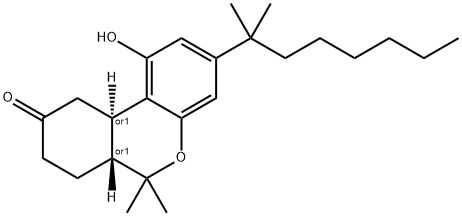
NABILONE-DEA SCHEDULE II
- русский язык имя
- английское имяNABILONE-DEA SCHEDULE II
- CAS №51022-71-0
- CBNumberCB4504001
- ФормулаC24H36O3
- мольный вес372.54
- EINECS637-087-5
- номер MDLMFCD00941490
- файл Mol51022-71-0.mol
| Температура плавления | 155-156°C |
| Температура кипения | 457.4±45.0 °C(Predicted) |
| плотность | 1.029±0.06 g/cm3(Predicted) |
| температура хранения | 2-8°C |
| растворимость | DMSO: ~18 mg/mL, soluble |
| форма | solid |
| пка | pKa in 66% DMF: 13.5(at 25℃) |
| цвет | white |
| Словарь онкологических терминов NCI | nabilone |
| FDA UNII | 2N4O9L084N |
| Словарь наркотиков NCI | nabilone |
| Код УВД | A04AD11 |
| Коды опасности | Xn,F |
| Заявления о рисках | 22-36-20/21/22-11 |
| Заявления о безопасности | 36/37/39-45-36/37-16 |
| WGK Германия | 3 |
| RTECS | HP8756000 |
| DEA Controlled Substances | CSCN: 7379 CAS SCH: II NARC: N |
рисовальное письмо(GHS)
-
рисовальное письмо(GHS)


-
сигнальный язык
предупреждение
-
вредная бумага
H302:Вредно при проглатывании.
H336:Может вызывать сонливость или головокружение.
H361:Предполагается, что данное вещество может отрицательно повлиять на способность к деторождению или на неродившегося ребенка.
-
оператор предупредительных мер
P202:Перед использованием ознакомиться с инструкциями по технике безопасности.
P261:Избегать вдыхания пыли/ дыма/ газа/ тумана/ паров/ аэрозолей.
P264:После работы тщательно вымыть кожу.
P270:При использовании продукции не курить, не пить, не принимать пищу.
P301+P312:ПРИ ПРОГЛАТЫВАНИИ: Обратиться за медицинской помощью при плохом самочувствии.
P308+P313:ПРИ подозрении на возможность воздействия обратиться за медицинской помощью.
NABILONE-DEA SCHEDULE II химические свойства, назначение, производство
Химические свойства
White to Off-White SolidИспользование
A labelled synthetic cannabinoid with antiemetic, antiglaucoma, and CNS activity. Antiemetic. Controlled substance (hallucinogen).Всемирная организация здравоохранения(ВОЗ)
Nabilone is a structural analogue of dronabinol (delta-9- tetrahydrocannabinol), the major active component of cannabis.Фармаколо?гия
Nabilone is a synthetic analogue of THC that has shown particular promise in laboratory models of CUD. Nabilone has better bioavailability, a longer duration of action, and lower abuse liability than dronabinol, and since it produces unique urinary metabolites, researchers can distinguish cannabis use from medication compliance. Haney et al. investigated two doses of nabilone in the human laboratory and showed that this medication significantly decreased a laboratory measure of cannabis relapse and improved mood symptoms of withdrawal, such as irritability. Further, the higher nabilone dose also decreased craving for cannabis, increased quality of sleep, and improved food intake. In 2016, Herrmann et al. used a similar human laboratory design to test the combination of nabilone and the GABAA agonist, zolpidem, hypothesizing that combining nabilone with an efficacious sleep medication may produce more robust reductions in cannabis withdrawal and relapse than those observed with nabilone alone by Haney et al. Zolpidem was also tested alone, and although it improved sleep during cannabis withdrawal relative to placebo, it did not reduce relapse. The combination of zolpidem and nabilone provided a more comprehensive reduction in withdrawal symptoms (negative mood, anorexia, disrupted sleep) and also reduced cannabis relapse. The authors suggest that the majority of these effects are attributable to nabilone. These laboratory findings await confirmation in clinical treatment settings, but the results of these studies demonstrate that nabilone holds considerable promise for CUD treatment.